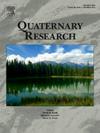巴西热带地区月桂藻(Lund,1842)的年同位素日粮(δ13C)和更新世晚期的气候变化(δ18O)
IF 1.8
3区 地球科学
Q3 GEOGRAPHY, PHYSICAL
引用次数: 3
摘要
摘要我们通过第三下臼齿的延伸推断了在Toca dos Ossos(Ourolândia,Bahia,Brazil)发现的巨型地懒Eremotherium laurilladi个体的年度同位素饮食(δ13C)。该个体生活在该地区,年BP为40779–39617卡。据记录,它的寿命为一年,牙齿长度为67毫米。有两年是以这种莫拉里形式记录的,在此期间,饮食和气候没有太大变化,年中出现了大量降水,这与现代模式相反。平均碳(μδ13C=-13.9±1.8‰)和氧(μδ18O=22.5±2.9‰)同位素值与同一洞穴中发现的其他物种的值相似,但与巴西热带地区其他地区的值不同,这使我们能够表明,与今天相比,该地区的降水量更多,温度更低。在E.laurillardi的年代化石和同一洞穴中发现的另外两个分类群(Toxodon platensis和Notiomastodon platensi)中发现的氧同位素值可能有助于理解该地区发生的气候变化。本文章由计算机程序翻译,如有差异,请以英文原文为准。
Annual isotopic diet (δ13C) of Eremotherium laurillardi (Lund, 1842) and climate variation (δ18O) through the late Pleistocene in the Brazilian Intertropical Region
Abstract We inferred the annual isotopic diet (δ13C) of an individual of the giant ground sloth Eremotherium laurillardi found in Toca dos Ossos (Ourolândia, Bahia, Brazil) through the extension of its third inferior molar. This individual lived in the region at 40,779–39,617cal yr BP. One year of its life was recorded in a length of 67 mm in the tooth. Two years were recorded in this molariform, during which the diet and climate did not change much, and substantial precipitation occurred during the middle of the year, which is in opposition to the modern pattern. The mean carbon (μδ13C = −13.9 ± 1.8‰) and oxygen (μδ18O = 22.5 ± 2.9‰) isotopic values were similar to values for other individuals of the species found in the same cave but different from the values found in other localities of the Brazilian Intertropical Region, which allows us to suggest that this region had more precipitation and lower temperatures in comparison to today. The oxygen isotopic values found in dated fossils of E. laurillardi and from two other taxa found in the same cave (Toxodon platensis, and Notiomastodon platensis) could help in the understanding of the climatic variation that occurred in the region.
求助全文
通过发布文献求助,成功后即可免费获取论文全文。
去求助
来源期刊

Quaternary Research
地学-地球科学综合
CiteScore
4.70
自引率
8.70%
发文量
57
审稿时长
3 months
期刊介绍:
Quaternary Research is an international journal devoted to the advancement of the interdisciplinary understanding of the Quaternary Period. We aim to publish articles of broad interest with relevance to more than one discipline, and that constitute a significant new contribution to Quaternary science. The journal’s scope is global, building on its nearly 50-year history in advancing the understanding of earth and human history through interdisciplinary study of the last 2.6 million years.
 求助内容:
求助内容: 应助结果提醒方式:
应助结果提醒方式:


